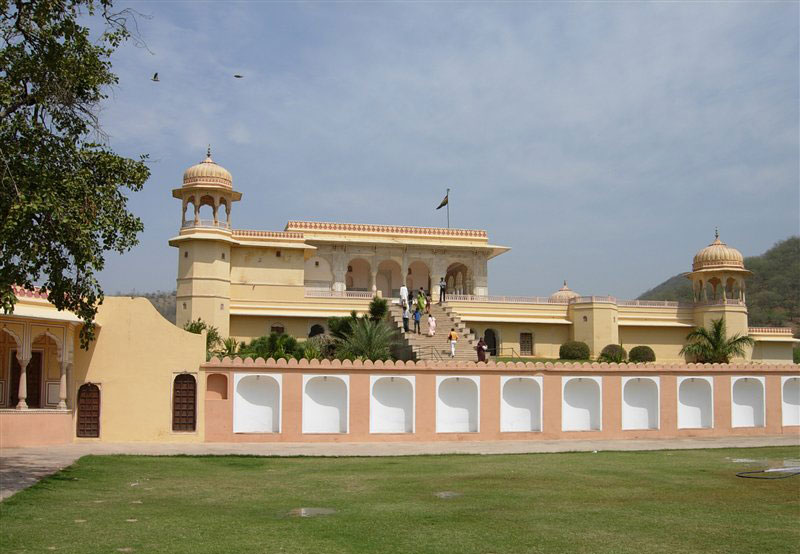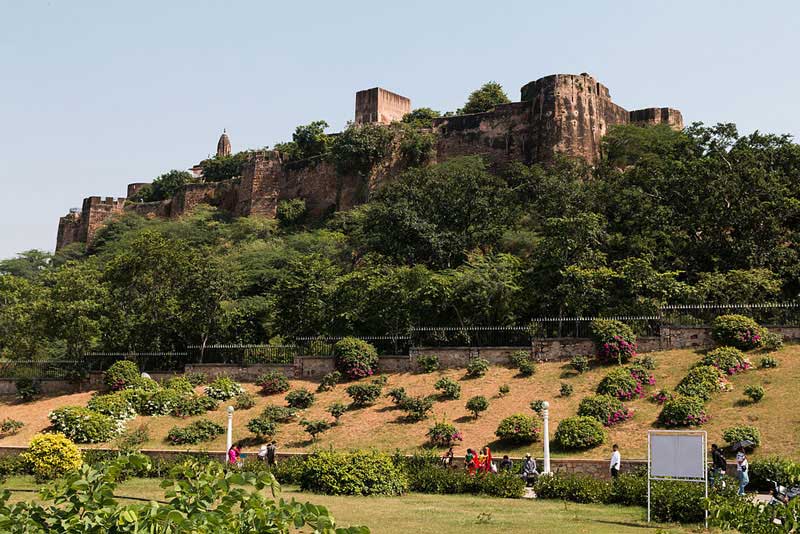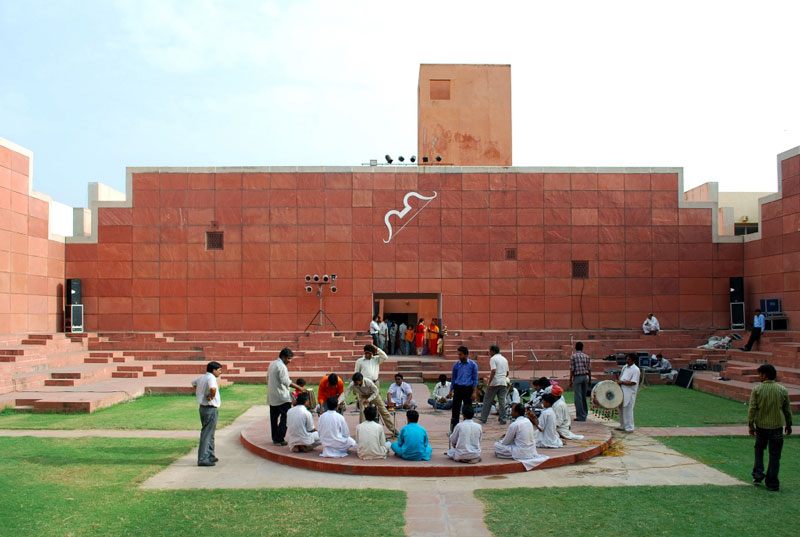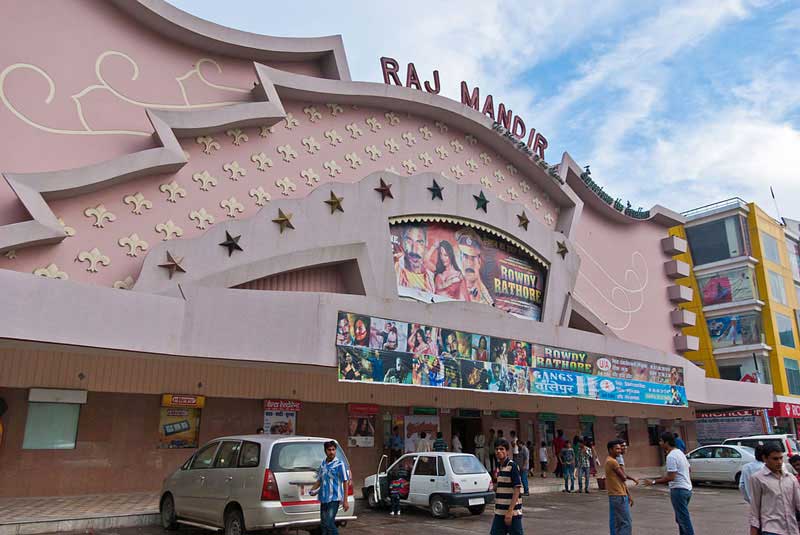1. Kanak Vrindavan/Kanak Ghati
 Built in a valley surrounded by the Aravallis, The Kanak Vrindavan Garden complex was commissioned during the reign of Maharaja Man Singh who was a devotee of Lord Krishna. The complex contains a beautifully designed garden with the signature Rajput chhatris, fountains and a marvelous temple dedicated to Lord Krishna and a zoological park. The valley park is full of gardens, lakes, open meadows and flowering plants along with a vantage point that offers some great views of Amer and Jaigarh Fort. The ponds and lakes in the valley are also decorated with statues that depict the life of Lord Krishna while growing up in Vrindavan.
Built in a valley surrounded by the Aravallis, The Kanak Vrindavan Garden complex was commissioned during the reign of Maharaja Man Singh who was a devotee of Lord Krishna. The complex contains a beautifully designed garden with the signature Rajput chhatris, fountains and a marvelous temple dedicated to Lord Krishna and a zoological park. The valley park is full of gardens, lakes, open meadows and flowering plants along with a vantage point that offers some great views of Amer and Jaigarh Fort. The ponds and lakes in the valley are also decorated with statues that depict the life of Lord Krishna while growing up in Vrindavan.
Entry Timings
8:00 am to 5:00 pm all days
Entry Fees
INR 10 for all visitors
Photo by xiquinhosilva, CC BY-SA 2.0
2. Sisodiya Rani Gardens
With architectural inspiration from the Mughal gardens, the Sisodiya Rani ka Bagh or Sisodiya Rani Garden is an 18th century structure built by Sawai Jai Singh II. The gardens were named after Jai Singh’s second wife who hailed from the Sisodiya family of Mewar (Udaipur) and are located at the foothills of the Aravali hills. The garden is designed in a multi-level layout with several pavilions, fountains and ornamental structures with several exotic species of flowering plants and trees. Several depictions of Lord Krishna and Radha have been painted on the palatial walls.
Entry Timings
8:00 am to 8:00 pm
Entry Fees
- Indian Visitors: INR 20
- Indian Students: INR 10
- Foreign Visitors: INR 50
- Foreign Students: INR 25
3. Statue Circle
Located in a posh suburb of Jaipur, the Statue circle garden serves as a traffic junction and a popular recreation spot for the locals. The statue refers to the idol of the founder of the city Maharaja Sawai Jai Singh II and stands in the honor of the great king. The statue is carved from a single piece of marble and depicts the King holding an astrological document. The statue takes the center stage and is surrounded by a well maintained garden with lights and fountains that make it perfect for an evening stroll. One can also visit the nearby Birla Auditorium and Convention center, which contains several attractions such as science museum, planetarium, library and an auditorium.
4. Garh Ganesh Temple
Located amidst the picturesque hillocks of Amer, the Grah Ganesh Temple was built by Sawai Jai Singh II. As the name suggests the temple is dedicated to Lord Ganesha who is depicted in his child form without his trunk. The temple was built prior to the establishment of Jaipur city and its idol is placed in such a way that it could be viewed from the City Palace with binoculars. The temple is much frequented by devotees throughout the year along with an annual 5 day fair during Ganesh Chaturthi (August-September) and the festival of Diwali (October – November). The Temple, apart from its spiritual connection also offers some panoramic views of the Jaipur city and is a great place to view the city lights on Diwali. The Jal Mahal is also viewed from the top and looks enchanting during the evening.
Entry Timings: 7:00 am to 12:00 pm, 4:00 pm to 9:00 pm
5. Moti Doongri Ganesh Temple
 The second of the two Ganesh Temples established by Sawai Jai Singh II, the Moti Doongri Ganesh Temple is located in close proximity to the Birla Mandir. The temple was built prior to the foundation of Jaipur for Lord Ganesha’s blessings before the founding stone was laid. The temple can be visited all days and a heavy influx of visitors can be seen on Wednesdays being the day of Lord Ganesh. The special sweets distributed, as Prasad (communion) is also a favorite among the locals and tourists. Special prayers are also offered during the festival of Ganesh Chaturthi, Diwali, Holi and Mahashivaratri and the temple is frequented by thousands of devotees. The temple is also visited by newly married couples and the locals who get their newly purchased vehicles for the blessing of Lord Ganesh.
The second of the two Ganesh Temples established by Sawai Jai Singh II, the Moti Doongri Ganesh Temple is located in close proximity to the Birla Mandir. The temple was built prior to the foundation of Jaipur for Lord Ganesha’s blessings before the founding stone was laid. The temple can be visited all days and a heavy influx of visitors can be seen on Wednesdays being the day of Lord Ganesh. The special sweets distributed, as Prasad (communion) is also a favorite among the locals and tourists. Special prayers are also offered during the festival of Ganesh Chaturthi, Diwali, Holi and Mahashivaratri and the temple is frequented by thousands of devotees. The temple is also visited by newly married couples and the locals who get their newly purchased vehicles for the blessing of Lord Ganesh.
Aarti Timings
- Mangal Aarti – 4:30 am (summers) and 4:45 am (winters)
- Dhoop Aarti – 7:15 am (summers) and 8:15 am (winters)
- Sringar Aarti – 9:15 am (summers) and 9:45 am (winters)
- Rajbhog – 11:00 am (summers) and 11:15 am (winters)
- Gwal – 6:30 pm (summers) and 6:45 pm (winters)
- Sandhya – 7:15 pm (summers) and 7:45 (winters)
- Shayan – 9:15 pm (summers) and 9:30 pm (winters)
Photo by Daniel Villafruela, CC BY-SA 3.0
6. Jawahar Kala Kendra
 One of the most prominent post-independence buildings in Jaipur, Jawahar Kala Kendra or ‘JKK’, was inaugurated in 1993 as a multi-arts and cultural center. The building was designed by legendary architect Charles Correa and takes influences from the Vastu Vidya inspired plan of the Pink City mixed with modern designs. Located on the Jawaharlal Nehru Marg, JKK contains an open amphitheatre, several closed theatres, a state of the art auditorium with projector, a cafeteria, library and several art exhibition rooms. The annual theatre festival held here every summer and the several exhibitions and fairs held here between October and January, make this place essential for the populace of Jaipur. Regular theatrical performances and skits are also organised during the weekends, which make it a definitive place to visit in Jaipur.
One of the most prominent post-independence buildings in Jaipur, Jawahar Kala Kendra or ‘JKK’, was inaugurated in 1993 as a multi-arts and cultural center. The building was designed by legendary architect Charles Correa and takes influences from the Vastu Vidya inspired plan of the Pink City mixed with modern designs. Located on the Jawaharlal Nehru Marg, JKK contains an open amphitheatre, several closed theatres, a state of the art auditorium with projector, a cafeteria, library and several art exhibition rooms. The annual theatre festival held here every summer and the several exhibitions and fairs held here between October and January, make this place essential for the populace of Jaipur. Regular theatrical performances and skits are also organised during the weekends, which make it a definitive place to visit in Jaipur.
Entry Timings: 9:30 am to 6:00 pm all days
Indian Coffee House Timings: 9:00 am to 9:00 pm all days
Photo by Sanyam Bahga, CC BY-SA 3.0
7. Raj Mandir Cinema Hall
 Opened in 1976, and built in a unique style that merges modern architecture with art deco influences, Raj Mandir Auditorium is one of the most popular cinema halls in Rajasthan. Although most of the older styled movie theatres in Jaipur are run down or shut due to the emergence of multiplexes, Raj Mandir still remains a much frequented attraction due to its unique architecture and striking interiors, which is it main highlight. Being Located at Panch Batti in a posh locality, the cinema hall remains highly visited by both locals and tourists.
Opened in 1976, and built in a unique style that merges modern architecture with art deco influences, Raj Mandir Auditorium is one of the most popular cinema halls in Rajasthan. Although most of the older styled movie theatres in Jaipur are run down or shut due to the emergence of multiplexes, Raj Mandir still remains a much frequented attraction due to its unique architecture and striking interiors, which is it main highlight. Being Located at Panch Batti in a posh locality, the cinema hall remains highly visited by both locals and tourists.
Photo by Antoine Taveneaux, CC BY-SA 3.0
8. Khole Ke Hanuman Ji Temple
Dedicated to the mighty monkey god, Lord Hanuman, the Khole ke Hanuman Ji temple is located at a picturesque setting amidst the Aravalli hills. The temple is said to have been founded at the spot where Lord Hanuman rested while looking for the magical herbs for the injured Lakshamana. For this reason, the image of Lord Hanuman is depicted in a reclining position in the temple. The premise recently underwent an extensive makeover by the State government and is now ornate with beautifully carved chhatris, gardens and fountains with huge entrances. Apart from the several shrines dedicated to the various gods and goddesses of the Hindu tradition, the temple is one of the best places to taste the famous ‘Dal, Bati, Churma’ during the several Goths (community dinners), that are conducted here on a regular basis.
Entry Timings: 6:00 am to 9:30 pm
9. Vidhyadhar Gardens
Located in close proximity to the Sisodiya Rani Palace gardens, the Vidhyadhar Gardens is a tribute to Vidhyadhar Bhattacharya, the chief architect of the city of Jaipur. The architecture of the gardens is predominantly Rajput, with the signature chhatris with an evident Mughal influence seen in the garden’s design. The walls are decorated with intricate murals depicting Lord Krishna along with several fountains and flowering plants. The design of the garden is homage to the architect’s distinctive style, based on the ancient city planning concepts of Vastu Shastra.
- Entry Timings: 9:00 am to 5:00 pm
- Entry Fees: INR 20 for Indian Visitors, INR 10 for Indian students, INR 50 for Foreign Visitors, INR 25 for Foreign Students.
10. Amer Sagar Lake
Located at a short distance from the Anokhi Museum, Amer Sagar Lake is one of the hidden jewels of Jaipur. Amer Sagar is a manmade lake built during the 17th century by Raja Man Singh of Amer. The lake is divided into two parts, the upper sagar and the lower sagar, of which the lower sagar was only filled once the upper sagar reaches its capacity. The place can be visited during all times of the year and is especially picturesque during the rainy season as one can witness a waterfall during this time. The place is not visited by many locals or tourists and is great for spending some tranquil moments in the forested surroundings. However, one should be careful around the lake, as there is no life guard or authorities for safety.